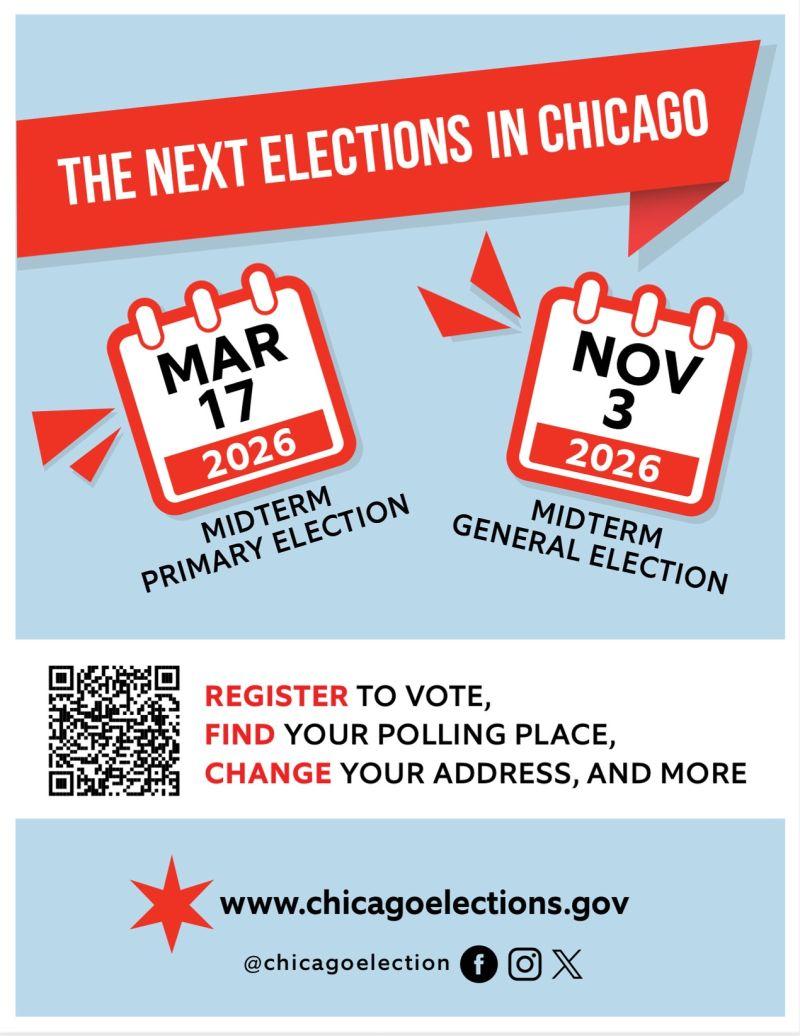

A Laddered Path to Black Wealth in Chicago
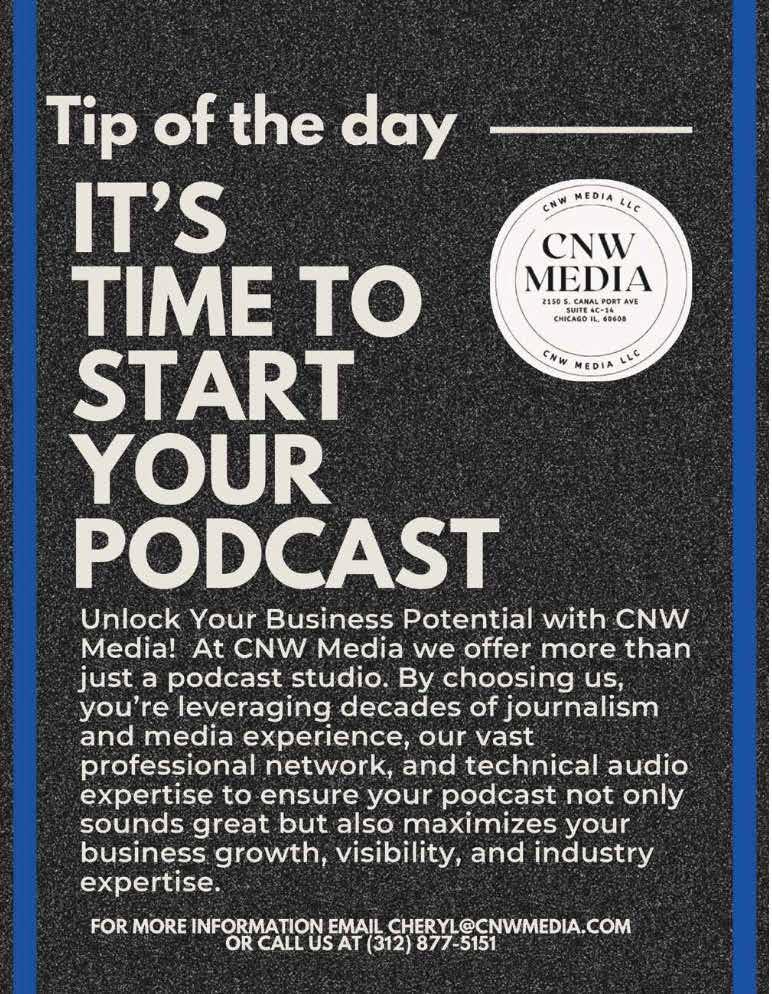

Cheryl Mainor Norman CEO & Publisher
Kai
EL’ Zabar Editor-In-Chief
Laura Miller Managing
Editor
Paul Mainor Art Director
Max Blaisdell Copy Editor
Staff Writers
CL Blackburn
Zada Johnson
Dr. Mila K. Marshall
Wanda Wright
Malachi Webster
Columnists
Dr. Sanja Rickette Stinson
David Seaton
Contributors
NNPA Newswire
Mare Evans
Melanie Mainor
Ken Hare
Cover Photo Icarus Yang/Unsplash
Advertising Representation
Chicago Media Partners
Michael Tolliver (708)268-5518
Kenard Karter
Kevin Ross
Chicago News Weekly 2150 S. Canalport Ave. Suite 4-C14 Chicago, IL 60608 312. 877. 5151
Vol. 3 No 12 Thursday, July 10, 2025
Chicago News Weekly is published weekly on Thursday.
www.cnwmedia.com advertising@cnwmedia.com editorial@cnwmedia.com
Subscription $104 year


E notes
Life Branding
We
are all spiritual beings living in a human body. Even though our design seems different, we are all granted our unique gift inside.
If you’re human, you’ve had the experience of meeting someone whose life seems so completely different or opposite from yours that you imagine having nothing in common other than being human. However, if curiosity drives your interest, it may behoove
you to pursue greater insight and seek a deeper peek into what makes that person tick. So, once you begin to observe them more intently with a specific intentionality, reality will reveal more than shared human emotions. Focus will have you see that we all have the same things going on in our lives, though they may be presented in different packages. With a greater sense of depth and insight, you may sense that what you thought at first seemed like two very different lives are, in essence, the same gift, presented in an infinite variety of packaging—boxes, bags, wrapping paper, ribbons, and bows.
Suddenly the idea of humanness shrinks the differences that appeared to be galaxies apart. You begin to grasp that every human being experiences loss, grief, happiness, excitement, anger, and fear in addition to hunger, pain, joy, triumph, and defeat. Everyone can have money issues of one kind or another, whether they are wealthy or impoverished, and everyone struggles with difficult choices. If that is still difficult to wrap your head around, consider your circumstances, life experiences, and all that you know and expect. Think about suddenly being forced to move from your comfortable accommodation to a tent and the loss of relationships with those who once were considered friends. Imagine them now looking at you as you have looked at the homeless—not with compassion and prayer, but rather with criticism and disdain, blaming you for your unfortunate sit-

uation. We look at others and make up our own stories about how they landed where they are. Suppose you were the vic-
or lack of understanding. One person may need to learn the value of money by having too little of it, while another may need
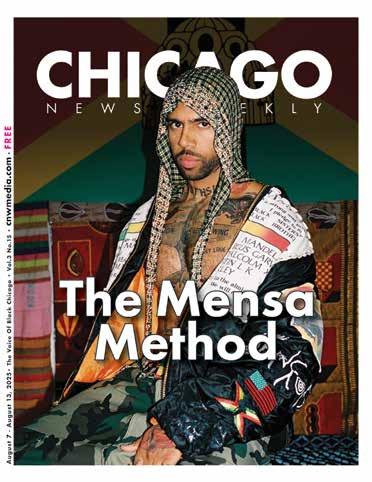
tim of fraud, and all your money was stolen? It happens. Let me share an insight. I learned this some time ago, and now I begin my day and end my day by thanking God for expressing itself through me being me. Lessons are taught according to our unique needs. Our lives show up differently for each one of us because we each learn in different ways. We each learn about work and love, with experiences that are tailored to our particular perspective and/
to learn by having more than enough. Though it may come across that some people have what seems easy while others are in a continual state of struggle, the truth is that we are all facing challenges on a daily basis. We are all in the school of life learning, and it is very difficult to tell, when looking only at the exterior of a person’s life, what’s going on inside.
We know this to be true because we know the folks who fake it until they make it. They
dress well, drive the big car, speak correctly, attend the right affairs, align with the winning side, and make it to the finish line as a winner. This they achieve with no money and their integrity intact, all because they were focused, intentional, and aligned with the outcome they were pursuing.
What you saw was what they wanted you to see—their vision in motion, or in popular vernacular... their brand. You never saw their bank account or their home. What you did see was the cover of their vision and the sacrifice that they were willing to make to reach their end goal. Such individuals are not delusional. They don’t go out of their way to show off and pretend to be what they are not. They act from a space of honesty and their own reality.
This is one of the many things that can be so valuable about cultivating relationships with people from all walks of life. As we get to know those who seem so different from us, we get to recognize how many of life’s challenges and joys are universal. We begin to look beyond the packaging of skin color, clothing preferences, socioeconomic differences, hairstyles, and the cars that we drive to the heart of the human experience. It is important to honor and value the differences in our packaging, even in a time when people consciously attempt to brand themselves. Note that it is important to honor the gift of life inside each one of us, and the fact that, no matter how different the packaging, the gift inside is constant.
Kai EL’ Zabar Editor-in-Chief
Photo: Dot Ward
THE BOOK OF DAVID Commentary
David Seaton CNW Columnist
Why Democrats Keep Losing the Middle Catering to the 1% While Ignoring the 99%
Ten years ago, while managing a call center for an insurance company, I got a front-row seat to the kind of cultural landmines that now dominate American politics.
One of my agents was dealing with a combative customer, so I stepped in. The caller had a deep, booming voice and a confrontational tone. I listened patiently to their grievances for several minutes before I said, “Excuse me, sir.”
That was all it took to derail the conversation. The caller cut me off to inform me they identified as female. I acknowledged it and moved on. But minutes later, as tensions rose again, I reflexively said, “Excuse me, sir” a second time. That’s when the customer erupted — yelling that their state had
a misgendering law and demanding my name so they could report me.
That’s the kind of absurdity that makes people in “blue states” roll their eyes, shake their heads, or pack their bags for somewhere else. In a country where the transgender community makes up roughly 1% of the population, state legislatures are writing laws to protect people from hearing the “wrong” pronoun — even if it’s an honest mistake — while the other 99% are dealing with skyrocketing taxes, deteriorating schools, failing infrastructure, and rising crime.
Every American deserves equal protection under the law. But there’s a difference between protecting people from discrimination and forcing the majority to speak, act, and think ac -
cording to the shifting preferences of a small, vocal minority. These so-called “misgendering” laws turn accidental slips into potential legal trouble. They aren’t about respect anymore — they’re about compelled speech, and that should concern everyone.
Democrats have made a fatal political miscalculation by bending their agenda to satisfy every fringe group that makes noise. Instead of focusing on the issues that unite voters — like job creation, affordable housing, safe neighborhoods, and a competent education system — they spend political capital on the pet causes of niche demographics. It’s not just tone-deaf; it’s self-destructive.
The reality is simple: most Americans don’t wake up in the morning wonder-

ing if someone used the right pronoun. They wake up worried about paying bills, keeping their kids safe, and whether their neighborhood is going downhill. When Democrats put more energy into legislating speech than fixing potholes, they hand their opponents a gift. If the party wants to win back Congress or the White House, it needs to start talking to the middle of America, not just the fringes. It means focusing on the 99% without letting the 1% dictate the national conversation. Until they do, they’ll keep bleeding voters, keep losing elections, and keep scratching their heads wondering why.
Because here’s the truth: Americans will forgive a lot in politics — incompetence, inefficiency, even hypocrisy. But they won’t forgive being ignored.
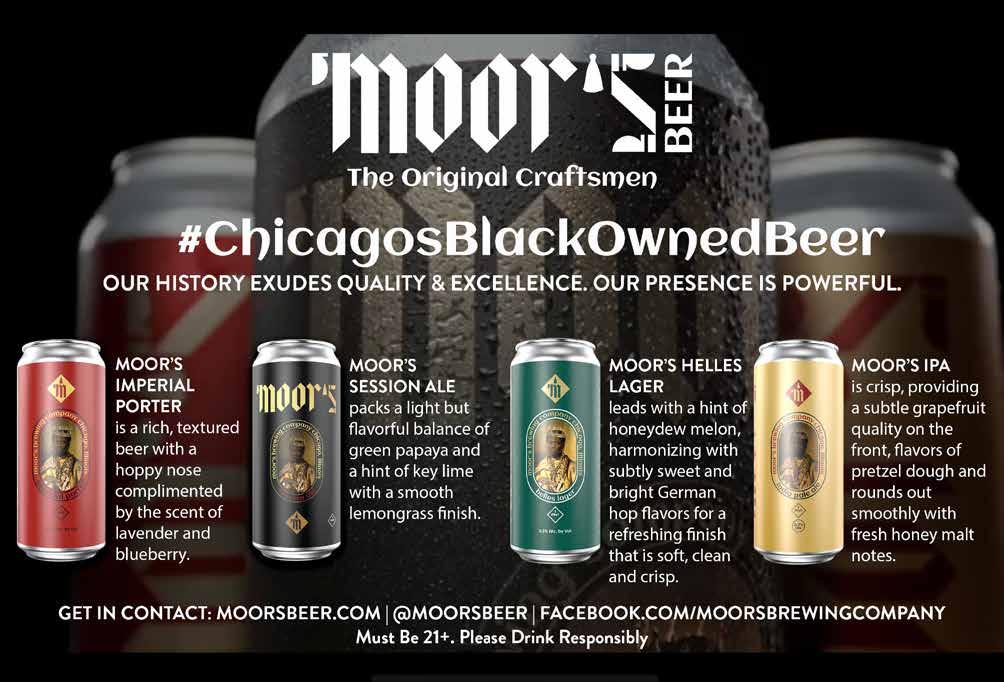
First Black Leader of Sierra Club Removed; Allies Call It Racism, Critics Blame His Management
The Sierra Club, the 133-year-old nonprofit environmental advocacy powerhouse, has fired executive director Ben Jealous “for cause”, according to Politico. Jealous, appointed in January 2023 and the group’s first Black leader, was removed after a months-long internal review that the board says was driven by performance concerns, but which his allies claim was motivated by racial bias. Why it matters: The Sierra Club is not just another nonprofit—it is one of the most politically influential environmental organizations in the United States, with a track record of shaping legislation, swaying elections, and mobilizing millions of members. This leadership crisis comes at a time when climate protections face political assault, federal environmental funding has been slashed, and the club is fighting to maintain credibility with donors, members, and the broader public. The outcome of this dispute could ripple far beyond the Sierra Club, influencing the direction of the U.S. environmental movement itself.
A Tumultuous Tenure
Jealous arrived with a high-profile résumé. A former NAACP president and Rhodes Scholar, he was recruited to lead the Sierra Club during what Politico described as “a time of significant, diverse challenges” for the organization. His appointment was hailed as a breakthrough for diversity in environmental leadership and as an opportunity to expand the group’s influence into politically conservative states.
But Jealous’s leadership quickly became a flashpoint. As Politico reported, his tenure included the disbanding of the Sierra Club’s equity team, an internal group tasked with advancing diversity and inclusion,

in 2023. Multiple rounds of layoffs followed, affecting staff across departments. The Progressive Workers Union, representing Sierra Club employees, accused Jealous of fostering an “adversarial” management culture and issued a formal vote of no confidence in his leadership. Union members cited “poor communication, lack of transparency, and destabilizing orga-
nizational changes” as reasons for their opposition.
Several current and former staff told Politico they experienced Jealous as an “abrasive” leader who made sweeping structural decisions without adequate input from the people carrying out the work. “It’s a relief,” one staff member said of his firing. “We can finally start to rebuild.”
Jealous Pushes Back
Jealous disputes the narrative that his leadership was divisive or ineffective. In a statement released via Stephanie Ong of Change LLC and published by Politico, he said:
“We created the most diverse leadership team in the club’s history, strengthened a weak financial base, crafted a progressive union contract, dramatically increased chapter directors in red states, and expanded our advocacy capacity… It is disheartening, unfortunate, but perhaps not surprising that the board has chosen an adversarial course… I have begun the process under my contract to fight this decision. I am confident we will prevail.”
Allegations of Racism
Some of Jealous’s most vocal defenders have framed his firing as part of a larger racial equity problem within the Sierra Club. Former board members Aaron Mair and Chad Hanson told Amsterdam News that Jealous has been the victim of “a pattern of misinformation, character assassination, and discrimination” that has plagued the organization for years. Mair, who himself made history as the Sierra Club’s first Black president in 2015, argued that Jealous inherited deep structural problems, including a $40 million deficit, yet still managed to stabilize finances and grow the organization’s presence in red states. According to Amsterdam News, Jealous’s allies see his removal as a warning sign that the Sierra Club has not fully confronted its internal culture problems, despite public commitments to equity.
Funding Pressures and Political Headwinds
The Sierra Club’s internal disputes are unfolding against a backdrop of serious funding
pressures. As The Guardianreported, the Trump administration enacted sweeping budget cuts to federal environmental programs, including the Environmental Protection Agency, the Interior Department, and Great Lakes restoration projects. These cuts weakened public funding for environmental advocacy and conservation, forcing nonprofits like the Sierra Club to rely more heavily on membership dues and large donors—funding sources that can fluctuate when the organization appears unstable.
The club has also taken legal action to fight these political headwinds. As Politico Pro detailed, it sued the Trump-era Office of Management and Budget to obtain records it claimed were unlawfully withheld concerning environmental budget reductions.
What’s at Stake
The firing of Jealous is more than an internal leadership shakeup—it raises existential questions for one of the country’s most influential environmental organizations. Supporters say Jealous was pushing the club to adapt to new political realities by expanding its base beyond liberal strongholds. Critics counter that his leadership alienated staff, weakened internal trust, and distracted from the mission.
With Jealous preparing to legally challenge the termination, the conflict is likely to spill into public view, potentially affecting donor trust, member engagement, and the Sierra Club’s political clout heading into an election cycle where climate policy is a major issue. Whether the case is ultimately decided in the courtroom or in the court of public opinion, the outcome will signal whether the Sierra Club can reconcile its environmental mission with the demands of equity, transparency, and effective leadership.
Hot Topic
California’s Driverless Car Race
Living in Chicago, we like to think that we’re progressive... and we are in some ways, but Los Angeles doesn’t get the credit it deserves for its innovative thrust. Last Friday I was riding in the passenger seat of a friend’s car when a driverless car pulled up alongside me. So, I began the drill. Of course, I thought it was Uber and Elon in some extended partnership. I mean, Elon’s Teslas saturate Uber because the drivers get a special deal if they purchase through Uber, so it was natural to think as I did.
So, when and how did LA get to where it is now?
Uber’s Journey in California
Uber began its autonomous testing in San Francisco, California, in December 2016. The brief launch of self-driving cars in San Francisco was quickly forced off the road by regulators due to lack of proper permits.

No such trial occurred in Los Angeles at that time. Then there was a fatal accident involving one of its autonomous vehicles in Arizona, and Uber halted testing everywhere. They then let their California testing permit expire on March 31, 2018.
Restart of Testing in California, February 2020
Come February 2020, Uber regained permission to test self-driving cars (with a human safety driver onboard) on Cali-
fornia roads. However, this permitted testing was in San Francisco—not Los Angeles. They announced restart intentions, but no implementation in LA was reported.
In January 2021, Uber sold its self-driving division (ATG) to Aurora, effectively ending their autonomous vehicle testing program. The only confirmed autonomous program in Los Angeles on the Uber platform involves autonomous food delivery, not ride-sharing. On May 16,

2022, Uber Eats partnered with Motional to begin driverless food delivery in Santa Monica. Uber’s future planning includes Uber’s first ride-hailing pilot with autonomous vans in Los Angeles scheduled for 2026, following a 2025 test phase. This is part of their partnership with Volkswagen to deploy electric autonomous ID. Buzz vans.
Waymo Takes the Lead
Uber’s failure to launch was not left void in Los Angeles. Instead, the driverless cars currently operating on public streets are owned and operated by Waymo (Alphabet Inc.). Waymo, who, what? Right? So short and sweet: Waymo is a subsidiary of Alphabet (Google’s parent company), which runs Waymo One, a fully autonomous robotaxi service in Los Angeles. It became available to the public in November 2024 and has around 100 vehicles serving a roughly 80 square-mile area across neighborhoods from Santa Monica to downtown L.A.... And as I’ve mentioned, I have witnessed them. Believe me, it’s uncanny.
If you’re familiar with LA, it’s not surprising that as of June 2025, Waymo expanded its coverage to include areas like Playa del Rey, Ladera Heights, Echo Park, Silver Lake, and the full stretch of Sunset Boulevard.
Motional
A look into the driverless race to dominate means looking at the timeline and the product. Motional (a joint venture between Hyundai Motor Group and Aptiv) conducted testing of fully driverless robotaxis in Los Angeles. Motional began road testing its all-electric Hyundai Ioniq 5s outfitted with LiDAR, radar, cameras, and autonomous software in 2021, in partnership with Lyft. It operates in Santa Monica and broader L.A. but primarily remains in the testing and pilot phase rather than full commercial deployment.
Contrast & Comparison
My research informs me that the driverless taxis seen actively ferrying passengers in LA are owned and operated by Waymo. Meanwhile, Motional is the other key player in the region—but currently focuses on testing their driverless systems rather than public rides.
Waymo’s Mission and Primary Objectives
Their intention is to scale fully autonomous ride-hailing (Waymo One) across diverse urban settings—making it a mainstream, everyday mobility choice. That’s huge and will change the trajectory for driverless cars like Uber transformed the taxi business. It’s real and it’s happening. Waymo prioritizes safety, currently claiming 88% fewer property-damage and 92% fewer bodily injury claims than human-driven vehicles per mile. Oh well. It sounds good, but I’m not sure. But think of the babies that will grow up with driverless cars as the norm. Finally, they are seeking growth in partnership models, so they align with automakers like Toyota, Hyundai, Jaguar, and Zeekr to diversify their fleet and even pave the way for personally owned autonomous vehicles. Integration with public transit rolled out February–April 2025 with a pilot offering $3 credits for rides that started or ended at select transit hubs— thus promoting seamless multimodal integration. Freeway and airport service in LA, including potential access to LAX per expansion filings—pending regulatory approval.
So, cities to watch in Waymo’s wider expansion blueprint through 2030 are Austin and Atlanta, where they are already expanding their reach, with Miami and Washington D.C. slated for 2026 and Dallas confirmed with fleet management by Avis Budget Group. Google’s Waymo is in full throttle. Internationally, early testing in Tokyo began in 2025, and exHOT TOPIC, Continued on page 16 u
Cori Bush Joins Ida’s Legacy
In 2017, a new organization emerged in Illinois with a clear mission: to support progressive African American women running for political office. Ida’s Legacy, the state’s first political action committee of its kind, was born. Its inaugural event, a summer mixer called “Legacy & Libations,” brought together four trailblazing women at different points in their political journeys. Attendees heard from Sharon Fairley, who was running for attorney general, and Nicole Johnson, a first-time candidate for alderperson. They were also joined by Donna Miller, who was considering her next campaign for the state Senate, and Lauren Underwood, who had just triumphed over six opponents in her primary race for Congress. All four candidates shared similar stories of being underestimated and underfunded, highlighting the unique challenges faced by progressive Black women in politics.
This year, Ida’s Legacy is proud to feature a former colleague of Lauren Underwood: U.S. Representative Cori Bush. A nurse, pastor, and community leader from St. Louis, Bush made history as

the first woman, the first nurse, and the first activist from the Black Lives Matter movement to be elected to Congress.
Throughout her two terms representing St. Louis’ 1st Congressional District, Congresswoman Bush’s personal experiences shaped her advocacy. She is a survivor of police, sexual, and domestic violence and has experienced being homeless and evicted. These struggles fueled her mission to serve all the people of her district, particularly those with the least.
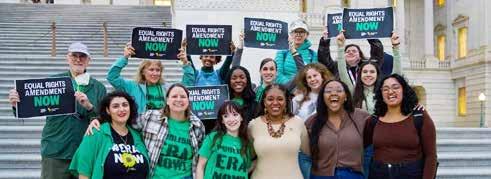
Last year, Bush faced one of the most expensive reelection campaigns in history, ultimately losing her seat. Special interest groups spent a staggering $19 million to defeat her, largely due to her outspoken stance on humanitarian conditions in Gaza.
Despite the loss, Bush’s farewell speech on the House floor was a powerful declaration of her unwavering commitment to her values. “I will keep leading with consistent love and consistent respect for all people no matter their background, no matter the color of their skin or where they were born,” she said. “I will continue to fight for every person’s right to live, to love and to thrive. I will keep standing up for a free Palestine, for a free
Haiti, for a free Congo, for a free Sudan, for a free St. Louis, for a free America and for a free democracy.”
She knew the potential consequences of her decisions, but chose to “be change, not chained.” As she so eloquently put it, “My radical and unconditional love for humanity is not a weakness, it’s my superpower.”
Bush will join Ida’s Legacy on Thursday, August 14, 2025, from 6:30 p.m. to 8:30 p.m. at Truth’s Italian Restaurant, located at 56 E. Pershing Rd. The event will feature a discussion on the current state of our nation’s politics, the vital role of Black women, and a path forward. For ticket information, visit www. idaslegacy.com or call 312-948-9951.

Health Equity in the Crosshairs How National Policies Could Widen Chicago’s Racial Life Expectancy Gap
On the West and South Sides of Chicago, a quiet crisis is unfolding. Black residents face an 11.4-year lower life expectancy than their non-Black counterparts—a gap that has barely budged, even as city programs attempt to bridge the divide. Now, looming national policy changes threaten to unravel hard-won progress and deepen disparities for Chicago’s Black community.
National Changes, Local Stakes
Proposed rollbacks to Medicaid coverage, potential cuts to the Affordable Care Act, and reduced funding for community health centers have left local leaders worried. Such federal shakeups could mean thousands of Chicagoans lose access to routine health care, mental health resources, or chronic disease management programs. At the same time, attacks on
workplace diversity, anti-discrimination enforcement, and public health initiatives raise the risk that health gains won’t reach those most in need.
These national stories—often framed as budget or ideological disputes—have concrete impacts in Chicago neighborhoods. For Black residents in Englewood and Austin, where hospitals have closed and primary care physicians are scarce, even a small funding cut can mean longer wait times, fewer specialists, and, too often, conditions left untreated.
Neighborhood Snapshots
Englewood stands out as one of Chicago’s most medically underserved areas. Local clinics may offer screenings or vaccinations, but staff note frequent barriers: lack of insurance, transportation, and knowledge about federal benefits. In Austin, violence prevention efforts and mental health partnerships have helped
stem some adverse outcomes, but a reduction in national support could see these programs scaled back or shuttered.
Chicago Solutions at Risk
Over the past five years, initiatives like Healthy Chicago 2025—a citywide public health blueprint—have targeted disparities by investing in violence prevention, public hospital upgrades, and chronic disease management. Grassroots efforts, ranging from pop-up wellness fairs to mobile clinics, were designed to close gaps and educate patients about their rights and options. Yet, relying on federal dollars means these solution-driven programs remain vulnerable.
“National funding changes don’t happen in a vacuum,” says Dr. Adrian Fields, a community health physician. “What gets cut at the top ends up hitting Englewood, Lawndale, and Austin the hardest. It’s not the -
oretical for us—it’s life and death.”
Why It Matters
Chicago’s racial life expectancy gap reflects historic and ongoing inequities. Every federal decision on health funding or outreach is magnified at the neighborhood level, dictating whether Black residents have timely access to care, healthy food, or trauma support.
If federal supports recede, the progress made—through local policy and persistent community activism—could be reversed, risking more preventable loss for Black families. Preserving and expanding health equity means joining national advocacy with investment in neighborhood clinics, preventive programs, and inclusive city initiatives. For Black Chicagoans, closing the life expectancy gap isn’t just a matter of numbers—it’s a fight for dignity, longevity, and justice.
What Is Fibermaxxing — and Should You Try It?
The internet’s newest nutrition buzzword is making waves, but experts want you to know the full story first
Anew nutrition trend is making the rounds on TikTok, and unlike many social media fads, it’s rooted in a genuinely beneficial nutrient: fiber. Called “fibermaxxing,” the movement encourages people to load their plates with high-fiber foods such as beans, lentils, whole grains, nuts, fruits, and vegetables—often to levels above the daily recommended intake. While the name sounds like something out of a fitness challenge, the idea has sparked conversation among nutrition professionals across the U.S. and abroad.
What Is Fibermaxxing?
Fibermaxxing isn’t an official medical term—it’s a piece of internet slang that grew from a genuine dietary gap. Most Americans consume only about 15–18 grams of fiber per day, well below the U.S. Department of Agriculture’s recommended 25 grams for women and 38 grams for men. Supporters of the trend see it as a catchy way to promote eating

more plants, whole grains, and legumes. Videos under the hashtag show TikTok creators adding chickpeas to pasta, mixing psyllium husk into smoothies, or snacking on roasted edamame. The tone is often upbeat, aiming to make high-fiber eating look fun and achievable.
Why Fiber Matters
Fiber is essential for digestion, helps regulate blood sugar, supports heart health, and can promote a healthy weight by keeping you fuller for longer. A high-fiber diet is also associated
with a lower risk of type 2 diabetes, colorectal cancer, and cardiovascular disease.
It’s little wonder, then, that nutritionists welcome efforts to close the fiber gap. As registered dietitian Grace Derocha told WXYZ Detroit, “Most of us simply don’t get enough, and this is one area where we could use a boost.”
Expert Cautions
Dietitians are quick to note that more isn’t always better—especially if you increase intake too quickly. Rapid fiber jumps can cause bloating, gas, and abdominal cramps.
Steph Grasso, a registered dietitian who spoke to ABC News’ Good Morning America, advises starting small: “Add fiber in increments and make sure you’re drinking enough water. Your digestive system needs time to adapt.”
Experts also warn against overemphasizing fiber at the expense of other nutrients. A balanced plate should include adequate protein, healthy fats, and micronutrients, not just fiber-rich foods.
Sidebar: Why Fiber Can Matter Even More for Some Communities
The official fiber recommendations are the same for all adults—25 grams daily for women, 38 grams for men— but some populations, including many Black Americans, are less likely to meet these goals due to structural barriers like limited access to fresh produce. Because Black Americans face higher rates of conditions like colorectal cancer and type 2 diabetes, meeting fiber goals may carry even greater potential health benefits. Experts say that improving access to high-fiber foods and tailoring nutrition education to cultural food traditions can make these benefits more attainable and sustainable.
CNW Staff Report
Kai
EL’ Zabar Editor-In-Chief
ARTS & CULTURE
Tapping Into Excellence at the Mayfair Arts Center
My first introduction to Rhythm World came through the Mayfair Arts Center (MAC), a legacy South Side institution. I knew Peggy Sutton, who leads it today, and respected her mission deeply.
Mayfair Academy of Fine Arts—also known as Mayfair Dance Academy— was founded in 1957 by Tommy and Amanda Sutton on Chicago’s South Side. Starting as a one-room school, it offered tap, jazz, ballet, and Afro-Cuban dance, giving neighborhood children, often excluded elsewhere, a place to learn and perform. Tommy Sutton,

a tap dancer, built the school on excellence, support, and community. Today, under their daughter Peggy’s leadership, Mayfair remains a cultural landmark.
In 2011, the Mayfair Academy became the Mayfair Arts Center, moving to a new building and broadening its reach beyond the South Side to serve the wider Chicago community.
In 2025, I attended the JUBALEE gala supporting MAC’s repair and expansion. Backed by an $800,000 City of Chicago grant and $450,000 raised so far, the event aimed to raise an additional $500,000 toward the $1.75 million “Tap into the Future” campaign.
The Chicago Human Rhythm Project (CHRP), organizer of Rhythm World, builds community through American tap and contemporary percussive arts, presenting performances, education, and outreach programs. CHRP hosts four annual events at venues such as the DuSable Museum, Harris Theater, and Fine Arts Building. Its ensemble, BAM!, offers after-school classes at local schools and has brought its “We All Got Rhythm” program to over 60,000 students in five years.


Tap, America’s contribution to global dance culture, blends African and Irish traditions, evolving over centuries into a distinct form seen in minstrel shows, vaudeville, Broadway, and Hollywood musicals. Icons like Bill “Bojangles” Robinson, Fred Astaire, and Gregory Hines helped define it. Productions like Savion Glover’s Bring in ’Da Noise, Bring in ’Da Funk reimagined tap as contemporary and politically relevant. CHRP was the first tap festival to become a year-round presenter, leading with concerts, outreach, and conferences while advocating for the art form.
When I attended Rhythm World at the Fine Arts Theater, I expected the kind of stagecraft and presentation that once amplified dance performances. Artists like Michael Jackson and Beyoncé understood the power of visual details— sparkling socks, iconic costumes—to draw focus to the artistry. By contrast, I recalled seeing Savion Glover at the Hollywood Bowl in a plain t-shirt; no matter how good his footwork, the lack of visual framing diminished the experience. At Rhythm World, the dancing was skillful, a mix of professionals and emerging talent, but the presentation
was bare—no costumes, no props, minimal staging. Even if the event was free, I missed the days when community volunteers built sets or lighting enhanced the backdrop. The musicians, notably, were better dressed than the dancers. The performance deserved more—es-
pecially for an art form with such a rich, proud legacy. Supporting MAC’s future means not only funding space and education but also ensuring tap’s presentation matches its artistry. Donate to MAC, and maybe, next time, help fund costumes worthy of the talent on stage.

A Laddered Path to Black Wealth in Chicago—From Disparity to Opportunity
On Chicago’s South Side, a quiet transformation is brewing. Jennifer Marshall, a third-generation resident of Auburn Gresham, stands outside the two-flat she now owns—an achievement her grandparents never imagined. Her journey isn’t unique, but it remains a rare success in a city where the median Black household net worth is nearly zero, compared to over $200,000 for White households. As Chicago approaches a pivotal moment, the conversation around economic disparity is shifting from simply identifying the problem to constructing pathways for Black Chicagoans to build generational wealth and resilience.
For generations, Chicago’s Black community has watched the city’s gleaming prosperity grow just out of reach. Now, community organizers, local entrepreneurs, policymakers, and families like Jennifer’s are laying new foundations— turning what seemed impossible into tangible progress. Understanding how to close the wealth gap is vital, not just for individual families, but for Chicago’s vibrancy, stability, and future.
Historical Snapshot: The Roots of Disparity
The story of Black wealth in Chicago is intertwined with the city’s rise and the nation’s struggle over who belongs. The Great Migration brought hundreds of thousands of Black families from the South to Chicago in the early and mid-20th century, seeking jobs and safety. But hopes clashed with redlining, restrictive covenants, and job discrimination.
Neighborhoods like Bronzeville became hubs of Black culture but also sites of high-density housing, poverty, and crime—outcomes fueled by a lack of investment. Many families, blocked from buying in white neighborhoods or accessing standard mortgages, watched home values stagnate and generational opportunities slip away. The resulting racial wealth gap isn’t just a matter of inequities in pay: it’s the legacy of structural injustice woven through policies, schools, banks, and city planning.
Despite these barriers, Black Chicagoans built powerful institutions—churches, cooperatives, businesses—that became pillars for resistance and recovery. But as the city evolved, these support systems suffered under the twin pressures of disinvestment and gentrification.

Turning Point: State of Black Chicago 2025
A new era is dawning. The Chicago Urban League’s “State of Black Chicago 2025” report outlines, for the first time, not just the depth of disparities but a roadmap for remediation. Rather than dwelling only on problems, community leaders are now demanding—and implementing—solutions:
- Homeownership initiatives: City and nonprofit programs help residents buy homes, keep intergenerational property, and avoid displacement.
- Entrepreneurship support: Grants and mentorship for Black-owned startups are on the rise.
- Workforce training: Investments in tech and trades are creating on-ramps
for young adults.
This new, action-oriented approach positions Black wealth-building as a shared cause, vital for everyone invested in Chicago’s survival and growth.
Homeownership Journey: Breaking Down Barriers
Homeownership is a crucial indicator of building generational wealth. Yet in Chicago, only about 39% of Black households own their homes—a figure that significantly trails that of White households, whose ownership rate is around 53%. The gap is even more stark compared to pre-1980s numbers, when discriminatory policies barred more Black families from buying property. This disparity means Black families, on
average, accumulate much less equity to pass on to children, deepening the city’s racial wealth divide.
In Roseland, Kevin and Tasha Price bought their first home with support from a city down-payment assistance program. Like many, they faced steep hurdles: high interest rates, unclear title documents due to family inheritances, and rising property taxes. But local nonprofits filled the gaps—connecting them with lawyers and financial literacy classes, helping them keep their property in the family, and advocating for property tax relief targeted at longtime residents.
Community organizations such as Neighborhood Housing Services (NHS) of Chicago, Greater Chatham Initiative, and the newly emphasized Northwest Center work to close this gap, providing homebuyer counseling, credit repair sessions, and access to low-interest loans, especially in neighborhoods threatened by gentrification or predatory development.
And there are opportunities to connect with resources: Metropolitan Family Services will host a Homeownership Resource Fair next month, featuring lenders, legal aid, and city agencies. Homeowners can meet with groups like Northwest Center on-site for personalized guidance and explore tools to fight displacement or navigate the process of purchasing a first property.
Sustaining Black homeownership in Chicago means more than property—it’s about community, autonomy, and passing opportunity to the next generation.
Entrepreneurship and Small Business Support
Chicago’s Black-owned businesses are vital engines of community stability, yet hurdles to accessing capital or commercial real estate remain daunting. Stephanie Evans, owner of Blackstone Bakery in Englewood, remembers being turned down by four banks before securing a microloan from a community development financial institution.
Pandemic relief programs gave her— and other small Black-owned shops—a lifeline, but new initiatives have taken stronger root. The Chicago Recovery Plan now provides grants and pop-up markets for startup owners, and incubators like West Side Forward churn out next-generation entrepreneurs equipped with the skills and networking they need to thrive.
Still, as Evans explains, “Mentorship
was just as important as the check. I learned to read contracts, build a business plan, and navigate licensing, all alongside peers who pushed me forward.” Sustaining this momentum will require continued access to low-interest loans, support for brick-and-mortar spaces, and citywide campaigns promoting spending at Black-owned businesses.
Workforce Development and Education
Emerging industries—renewable energy, healthcare, technology—offer promise, but only if Black Chicagoans can access the right training. The city’s Workforce Talent Innovation Grant partners with local community colleges and tech bootcamps to teach digital skills, coding, and other in-demand trades.
Antonio Williams, 25, once skeptical about these programs, now repairs and installs solar panels in Lawndale, earning a salary that allows him to save and support family. “I’m now thinking about buying a place, maybe starting my own company—things nobody in my family has done before.”
For many, upskilling is not just about getting a job—it’s about breaking out of cycles of instability, staying ahead of automation, and participating in Chicago’s economic revival.
Policy and Public-Private Partnerships
Lasting change hinges on coordinated action. In recent years, City Hall, local banks, and advocacy groups have aligned to:
- Increase affordable housing through targeted development.
- Launch anti-displacement ordinances for families in fast-gentrifying areas.
- Pass state funding for Black small businesses.
- Attract anchor institutions—universities, hospitals—to invest in Black-majority neighborhoods.
Public-private collaborations, like the Chicago Connected program (bridging digital divides), prove what’s possible when the city embraces equity as a guiding principle. Without such partnerships, well-meaning policies often unravel due to lack of buy-in or resources.
Voices from the Community
The heartbeat of these efforts beats strongest in barbershops, block clubs, and neighborhood resource fairs. Parents like Omar Jackson worry about rising rents and displacement but draw hope from seeing his daughter intern at a local Black-led tech firm. “We need to see ourselves as the main characters, not bystanders, in Chicago’s next chapter.”
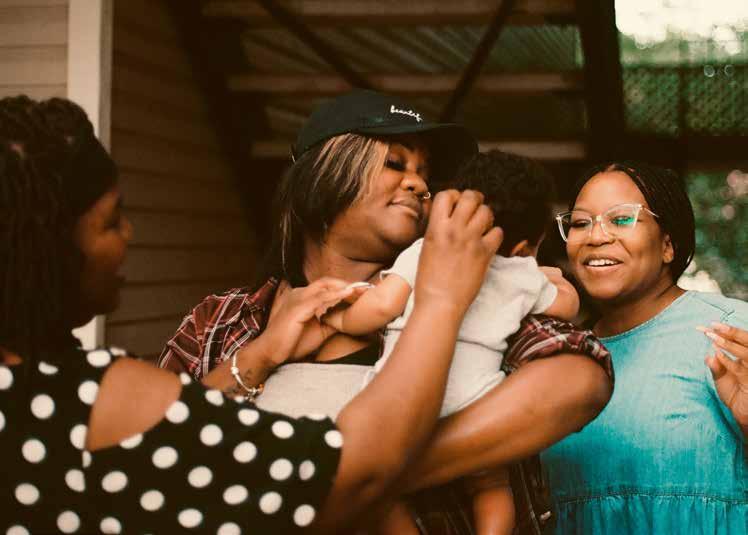

‘Why it Matters’—To Black Chicagoans, and the City at Large
The stakes are generational: Narrowing the racial wealth gap isn’t about enrichment for a few, but revival for entire communities. When Black families thrive— owning homes, running businesses, and accessing good jobs—the ripple effects touch every corner of Chicago:
- Reduced crime and violence
- Growing school quality and stable enrollment
- Higher civic participation levels
- Vibrant, more inclusive small business corridors
The city can’t afford to ignore these dynamics. As investment returns to the
South and West Sides, ensuring Black Chicagoans are central—not peripheral—will define whether Chicago emerges as a model metropolitan comeback or repeats cycles of exclusion.
Call to Action and Resources
Progress requires participation from every Chicagoan. Here’s how to get involved or benefit:
- Chicago Urban League: Advocacy, small business support, workforce training.
- NHS of Chicago: Homeownership counseling and grants.
- Greater Chatham Initiative: Entrepreneur workshops, community events.
- West Side Forward: Business incubator, mentorship, youth programs.
- Northwest Center: Homeowner resources, financial counseling, displacement prevention.
- Chicago Connected: Free or low-cost internet for qualifying families. Upcoming: the Homeownership Resource Fair (Metropolitan Family Services, next month)—connect to funding, advice, legal help, and city resources. Whether you’re a policy maker, business owner, or neighbor, the next phase of building Black wealth in Chicago is already underway. The question is not whether change can happen, but how many will join to accelerate it—and ensure that every resident, regardless of zip code, can share in the city’s promise.
Love and Relationships
One-Sided Friendships Looking at Both Sides of the Street
This week, I want to deviate from our usual relationship format and focus on a relationship we often value deeply but sometimes forget needs preserving—friendship. We talk a lot about how to nurture romantic relationships or family bonds, but friendships, too, need attention, boundaries, and care if we want them to last.
Friendship is often described as a twoway street—each person walking toward the other with time, care, and mutual respect. But sometimes, without realizing it, that road can become a one-way lane. The imbalance can be subtle at first—a missed text, an unanswered call, a gradual shift where one person gives more and receives less. We tend to notice it most when we feel we’re the ones doing all the work. But there’s another side to this conversation: what if we are the one-sided friend
One of the most valuable tools for keeping friendships healthy is understanding boundaries and expectations. Every friend has different capacities for how they show up. Some are available for deep, late-night conversations; oth-
Sports

ers thrive in quick catch-ups or sharing small, light moments. The trouble begins when we expect someone to be “everything” to us—emotional counselor, daily chatter partner, constant cheerleader— without considering their bandwidth or season of life.
I’ve experienced this firsthand. I have friends I adore but can’t always pour my heart out to during the day. Not because they don’t care, but because they work high-pressure jobs where even texting back can feel like juggling knives. When they send a short, clipped reply, I’ve learned it’s not a sign they’re distant—
it’s shorthand communication, squeezed between meetings. Early on, I sometimes misread it as disinterest, but now I recognize it’s just a matter of timing, not affection.
It’s easy to spot when we’re the one over-giving and under-receiving. Harder still is asking ourselves:
Am I expecting more than this person can realistically give right now?
Do I only reach out when I need support, but disappear when things are going well?
Have I taken time to check in on them, or am I mostly focused on my own updates and needs?
These questions aren’t meant to induce guilt—they’re meant to bring awareness. Friendships thrive when both people take responsibility for nurturing the connection. That means recognizing when we might be placing too much pressure on the other person to meet our needs, and balancing that with curiosity, patience, and generosity toward them.
The truth is, most friendships aren’t perfectly balanced at all times. Life naturally creates seasons of give and take— sometimes we’re the one doing more,
sometimes they are. But a consistently one-sided dynamic, whether we’re the giver or the taker, eventually wears down trust and connection.
Looking inward is the first step toward healthier relationships. If we realize we’ve been leaning too heavily on a friend without offering the same in return, it’s not about shame—it’s about taking small, intentional steps to shift the balance. That might mean reaching out to ask how they’re doing without slipping into our own updates, respecting their time when they’re busy, or widening our circle so no single friendship has to carry the full weight of our needs.
On the flip side, if you feel like the one always holding the friendship together, you can still show grace while also setting boundaries. Express what you need, give them space to step up, and if they don’t, accept that some friendships work best in smaller doses.
Friendship doesn’t have to be constant to be real. The ones worth keeping are often the ones that can go quiet without disappearing—and where both people, in their own ways, keep walking toward each other.
Shedeur Sanders Shines in Preseason Debut
Friday night, Cleveland Browns rookie quarterback Shedeur Sanders was thrust into the NFL spotlight after hamstring injuries sidelined fellow quarterbacks Dillon Gabriel and Kenny Pickett earlier this week. The fifth-round pick out of Colorado and Jackson State had the eyes of the sports world on him, and he delivered. Sanders completed 14-of-23 passes for 138 yards and threw two touchdowns en route to a 30-10 victory over the Carolina Panthers in Uptown Charlotte.
While in the game, Sanders led the Browns on three touchdown drives. Notably, Sanders completed 11 of 18 passes for 103 yards, two touchdowns, zero interceptions, and a 113.9 passer rating in the first half.
Yes, Shedeur was projected to go in the first round of April’s NFL Draft. However, when he fell to the fifth round, it was not due to a lack of playing ability. It was due to perceived distractions.

A sizable portion of the mainstream media was proved wrong Friday night when Sanders turned lemons into lemonade. And predictably, when Shedeur was asked whether he would move up the depth chart, he was not concerned with the idea.
“I honestly don’t know and I don’t really care,” Sanders admitted to Browns sideline reporter Aditi Kinkhabwala.
“Whenever it’s my time, I have to take advantage of it. I feel like I did some good, some bad, and going forward, I won’t make the same mistakes twice.”
Before he was told he’d start Friday’s game, Sanders was the fourth-string quarterback behind an 18-year-veteran quarterback in Joe Flacco, plus the aforementioned Pickett, and Gabriel. As a result, Sanders did not get reps with the first team offense. Friday night, Sanders played with the second-string offense.
His play drew praise from many observers on social media. Quickly after Shedeur threw his first touchdown pass, Deion Sanders praised the Lord on X. Entertainer extraordinaire Jamie Foxx said Shedeur was balling.
“He’s the real deal,” Foxx said. “Now, how y’all feel now? How y’all feel now?
No matter what he do, how y’all feel now? That man [is] playing for his daddy. If you hate Shedeur, you hate football. How can you hate this story?”
Where Shedeur Sanders goes from here is anyone’s guess. However, he gave himself a C+ for getting the win while not taking advantage of the opportunities available during the game.
“I’m just getting my feet wet, it was a good practice showing overall,” Sanders told the NFL Network’s Cameron Wolfe. “There’s definitely room for improvement in many areas.”
Sanders also acknowledged the support from the fans. He said he is playing for ‘people who don’t have a voice.’
“So, who I’m playing for is for people locked up,” Sanders continued. “The external motivation I have is crazy. Regardless of how I’m feeling, there are a lot of people counting on me to succeed. I got to make sure to stay positive, regardless of what’s going on.”
Photo Credit: Erik Drost
a.i. The Answer Is
CNW Staff Report
What’s the Difference Between the Declaration of Independence and the U.S. Constitution?
At this point in time, you probably won’t be surprised by how many people confuse the two when citing quotes— from presidents to political pundits who have referenced the wrong document in their speeches. And that, my beautiful people, is an atrocity. Especially in this day and age, we must be very clear about our rights, values, and the foundation upon which we stand, so presidents, if no one else, should be grilled and pressed to know the Declaration of Independence and the U.S. Constitution. Note that newly naturalized immigrants must know the U.S. Constitution and its amendments.
1. The U.S. Constitution and Bill of Rights
The Constitution is the supreme law of the land, establishing the framework
of the U.S. government and defining its powers.
The Bill of Rights comprises the first ten amendments to the Constitution, guaranteeing fundamental rights and freedoms to all individuals in the U.S., including freedom of speech, religion, and the right to due process.
2. The Declaration of Independence
This document proclaimed the thirteen American colonies’ separation from Great Britain and articulated the core principles upon which the U.S. was founded, including the belief that all individuals are created equal and possess inherent rights to life, liberty, and the pursuit of happiness.
3. The Principles of American Democracy and Civics
Understanding the System of Government: This includes knowing about
The answer.is...
the three branches of government (legislative, executive, and judicial), their functions, and the system of checks and balances that prevents any one branch from becoming too powerful.
Rights and Responsibilities: Immigrants are expected to understand the rights and responsibilities of citizenship, including the right to vote (for citizens), the obligation to obey laws, and the principles of freedom and democracy upheld in the U.S.
Key Historical Events: Understanding major historical events and figures that shaped the U.S. is also crucial, including the reasons for the American Revolution, important wars, and significant social movements.
Newly immigrated citizens must also be familiar with the various immigration documents and procedures, depending on their specific immigration status.
This includes understanding their rights when interacting with law en-
forcement and immigration officials, such as the right to remain silent and the right to legal counsel.
It’s important to remember that these are just a few examples of the key documents and areas of knowledge.
Let’s look at the difference between the main two:
The Declaration of Independence...
...is about 1,300 words long. ...begins with: “When in the course of human events...”
...separated the 13 original colonies from the control of Great Britain.
...does not govern the American people (though its ideals, notably the concept of “life, liberty, and the pursuit of happiness,” are embraced by citizens as an expression of quintessentially American values).
...was signed by 56 men beginning on

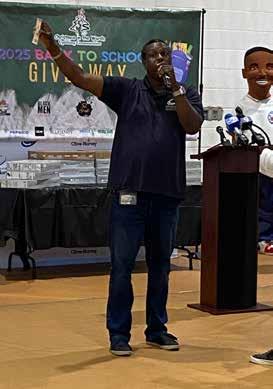
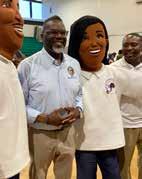




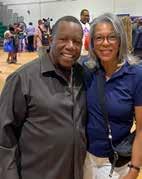




Community Chi-Lights

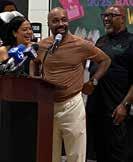


Christmas in the Wards Brings Big Back-to-School Celebration to Chicago’s South Side
Last Friday, Mayor Brandon Johnson joined Christmas in the Wards (CITW) and a host of community partners in turning Olive-Harvey College into a joyful hub for South Side families during the annual Back-to-School Giveaway and Carnival. In partnership with Rite-Way Huggins, In His Hands Resource Center, ComEd, Black Men United, Pepsi, S2 Grill, and local aldermen, the event provided more than 1,000 backpacks filled with school supplies to invited students from 11 South Side wards. But it was more than just backpacks — children enjoyed a bouncy house, Italian ice, a farmer’s market hosted by Mariano’s, free lunches from S2 Grill, and household essentials. Beloved children’s character Bluey posed for photos, and In
His Hands Resource Center distributed
“Be the Voice #StopSuicide” clothing to raise awareness about teen suicide prevention. Larry’s Barber College offered free haircuts and braiding to ensure students looked and felt their best for the first day of school.
Each participating ward also honored one student with a brand-new laptop, bridging the digital divide for the school year ahead.
“These giveaways are not charity—they are equity,” said CITW Founder Larry Huggins. “We’re helping kids go back to school prepared and confident, and we’ll be back in December to bring holiday joy.”
Since 1997, CITW has grown into a year-round mission, providing essentials, technology, and resources to fam-
ilies across Chicago and nearby suburbs.
Rev. John Harrell Launches Campaign for Illinois 8th District State Representative Sunday, August 11, 2025 – MacArthur’s Restaurant
This past Sunday, the historic MacArthur’s Restaurant on Chicago’s West Side was the setting for Rev. John Harrell’s official announcement that he is running for Illinois State Representative in the 8th District. Harrell, a longtime pastor and community leader, outlined his campaign vision focused on economic equity, public safety, educational access, and building stronger regional partnerships.
The event drew a diverse crowd of civic leaders, clergy, elected officials, and
celebrities. Notable attendees included Pastor Michael Eaddy, Pastor Ira Acree, Pastor Marshall Hatch, Pastor Reginald Bachus, businessman Larry Huggins, community matriarch Mother Josephine Wade, Cook County Treasurer Maria Pappas, Senate Majority Leader Kimberly Lightford, State Senator LaKeshia Collins, actors Larenz Tate and the Tate Brothers, philanthropist Dr. Willie Wilson, and multiple suburban mayors. Harrell emphasized unity across communities: “We are taking the next step toward a stronger 8th District — together.”
With support from faith leaders, business owners, political allies, and community activists, Harrell’s campaign officially kicks off as he seeks to represent and advocate for the district in Springfield.

Chicago’s Black Arts Renaissance Music,
Murals & Museums as Agents of Healing and Change
On a warm summer evening in Bronzeville, a vibrantly painted mural comes to life, boldly declaring “Healing Happens Here.” Just steps away, a community-driven open mic night unites youth and elders in a celebration of spoken word, jazz, and hip-hop. Chicago’s Black arts renaissance is more than cultural expression—it’s a force for public health and healing.
The Art of Healing
Local artists and cultural institutions increasingly use their platforms to address violence, trauma, and health disparities. Muralists create public art in neighborhoods scarred by loss, honoring victims and inspiring resilience. Creative organizations partner with clinics and social workers, integrating art therapy and storytelling into programs for those affected by gun violence or chronic stress.
Museums like the DuSable Museum of African American History curate exhibits highlighting community healing, inviting residents to share their own health journeys. Music festivals and pop-up performances blend entertainment with workshops on mental health and well-
u A.I., Continued from page 13
August 2, 1776, and possibly not signed by the last signer until 1781.
The U.S. Constitution...
...is about 7,500 words long, including
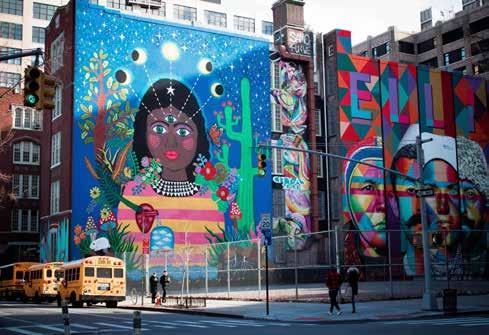
ness, delivering resources in spaces where people feel safe and seen.
Profiles and Voices
Take Nia Johnson, a muralist from Englewood, whose “Walls of Hope” project invites neighbors to paint their stories alongside wellness messages. “Art breaks isolation,” she shares. “When we create together, we heal together.”
27 amendments.
...begins with the words “We the People...”
...governs Americans and provides for the executive, legislative, and judicial branches of government.
Educators at local museums note a boom in youth programs connecting creativity to coping strategies, helping young Black Chicagoans process grief and build confidence. Musicians like Malik Reeves use performances to advocate for mental health, sharing their own battles and encouraging audiences to seek help.
Community, Connection, and Public Health
Arts events are increasingly designed as resource hubs, combining concerts or gallery shows with health screenings, therapy sign-ups, and information tables for organizations like the Chicago Urban League and the city health department. These creative spaces foster pride and solidarity, helping Black Chicagoans see themselves reflected in city culture—and empowering them to seek out wellness and support.
Why It Matters
For neighborhoods often targeted only for their struggles, Chicago’s Black arts renaissance reframes the narrative. It bridges gaps in health access, addresses trauma outside the hospital, and activates joy and resilience.
Where public health meets creative energy, real change happens—building safer, stronger, and more vibrant communities, one song, mural, or museum night at a time. For Chicago’s Black community, the arts are both a mirror and a medicine, making wellness and hope accessible to all.
...is the document that presidents, soldiers, government officials, and new American citizens must swear to uphold and protect.
...was signed by 39 men on September 17, 1787, and later ratified or accepted by all 13 states.
Given America’s current situation, we would all do well to familiarize ourselves with these two documents and do all that we can to uphold and protect them.
Voices of Our Youth






u HOT TOPIC, Continued from page 6
pansion into New York City is underway via data collection and advocacy for regulatory updates. So where is Chicago in

If things go according to plan, analysts predict that by 2030, Waymo might operate ~23,000 robotaxis conducting 125 million trips annually. Their “generalizable autonomous driver” aims to support diverse vehicle platforms and environments—not just ride-hailing, but personal ownership too. Devastating goes the Uber choice as a means for drivers to make money... but it does cut out the negative and ignorance of drivers.
Next Question: What are Los Angeles’ Plans to Include Waymo in the 2028 Olympics?
Though Waymo hasn’t publicly confirmed including the 2028 Summer
Olympics in its roadmap, there’s a compelling context in LA’s broader transit strategy. The “Twenty-eight by ‘28” initiative aims to complete 28 major transportation infrastructure projects before the start of the 2028 Summer Games on July 14, 2028. This includes rail expansions, freeway improvements, airport connections, and transit hubs. Plus, LA is leaning into the concept of “no-car Games,” prioritizing public transit, shuttle networks, bus lanes, and mobility hubs to mitigate traffic congestion and improve spectator flow— which is a move that can really play into Waymo’s favor.
Stay tuned and we shall see. With Waymo already operating in LA and expanding, it’s plausible—though not officially stated—that robotaxis could play a supporting role in transportation during or post-Olympics. Until there’s a formal announcement, however, this remains speculative.
So, What’s Going On with Toyota’s Partnership with Waymo?
The fairly new relationship began in April 2025, when Toyota and Waymo entered a preliminary collaboration to jointly develop a new autonomous vehicle (AV) platform, combining Waymo’s advanced software stacks with Toyota’s mass-manufacturing strengths and safety focus. The key goal is to create a robotaxi platform. Thus Toyota may supply purpose-built vehicles for Waymo’s ride-hailing fleet (Waymo One), augmenting its existing relationships with automakers like Hyundai and Zeekr.
And that, my friend, opens the door for Personally Owned Vehicles (POVs). This marks the first time Waymo’s technology may be licensed for integration into consumer vehicles. Toyota’s in-vehicle safety suite (Toyota Safety Sense) could be enhanced with Waymo’s autonomy for future models. Woven by Toyota, Toyota’s software and mobility R&D arm (which also heads the experimental Woven City near Mount Fuji), will be central to this effort. Imagine that—your own chauffeur.


Mare Evans Contributing Writer
Spicy Chipotle Honey Salmon Bowls
Crazy that it’s summertime and already fall is upon us! I share recipes that I love, that are delicious, healthy, smell good, and look good on a plate. As you can imagine, I have quite a collection now. But this morning I was watching NBC and Tom Llamas took Al Roker to Miami to share the cuisine of his Cuban roots, which was a continuation of the notion that “spicy” is a fad these days. When I discover an all-around great recipe because it’s so delicious, I am excited and say, “Thank goodness I have you to share these mouthwatering recipes with!” If it feels like I’ve already shared this one, I haven’t, but I love salmon, so I’ve provided you with a variety of salmon dishes. But this one—this one is one of my top 10 summer, anytime-of-theyear recipes.
Spicy Chipotle Honey Salmon Bowls:
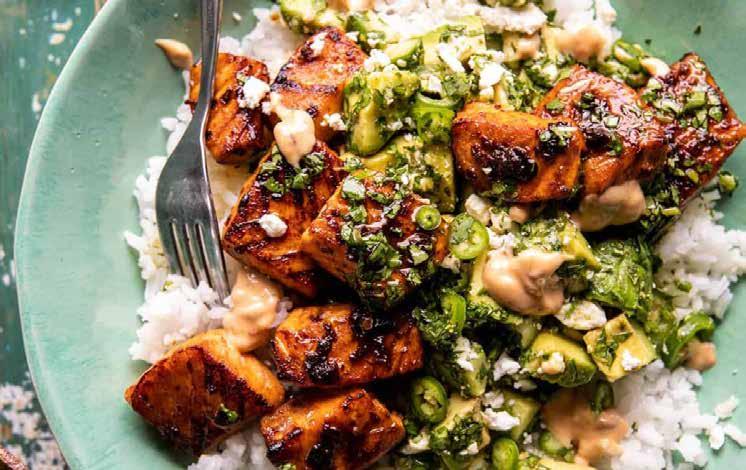
smoky, slightly spicy, chipotle roasted salmon, with cilantro vinaigrette, served over bowls of steamed rice with a salted feta and avocado salad... plus some creamy chipotle mayo too. It’s perfection! The beauty of this dish’s colorful onset of fresh salmon bowls makes it

appear lavish and difficult to master. It’s not. It’s simple to make and full of so much flavor.
This recipe delivers on its promise because it has everything good piled into one bowl: steamed rice, chipotle roasted salmon, a salty and creamy avocado feta
Ingredients
For the Salmon:
- 4 (4-6 ounce) salmon fillets, cut into bite-size chunks
- 6 tablespoons extra virgin olive oil
- 1-2 tablespoons chopped chipotle in adobo
- 2 tablespoons, plus 2 teaspoons honey
- 1 tablespoon tamari or soy sauce
- kosher salt and black pepper
- 1 tablespoon apple cider vinegar
- 1/2 cup fresh cilantro, chopped
- 3-4 cups cooked rice
Avocado Feta Salad:
- 2 avocados, diced
- 2 small cucumbers, chopped
- 1 serrano or jalapeño, sliced
- 1/2 cup fresh cilantro, chopped
- 1/2 teaspoon ground cumin
- 1/2 cup crumbled feta cheese
- 2 tablespoons extra virgin olive oil
- 1 tablespoon lemon juice
- 1 tablespoon lime juice
Chipotle Mayo:
- 1/2 cup mayo
- 1-2 tablespoons chopped chipotle in adobo
- 2 teaspoons honey
salad, plus some chipotle mayo to really round out the bowl. It’s filling yet light and digests quickly, leaving you satisfied and comfortable.
Prep Time: 25 minutes
Cook Time: 15 minutes
Total Time: 40 minutes
Instructions
1. Preheat the oven to 450°F.
2. On a baking sheet, toss the salmon pieces with 3 tablespoons olive oil, chipotle in adobo, 2 tablespoons honey, tamari (or soy sauce), and a pinch each of salt and pepper. Arrange in a single layer. Roast 1015 minutes or until the salmon is cooked to your liking. During the last minute, switch the oven to broil and broil until lightly charred. Set the salmon aside.
3. In a small bowl, whisk together 3 tablespoons olive oil, 2 teaspoons honey, and the apple cider vinegar. Stir in the cilantro and season with salt and pepper. Set the sauce aside for serving.
4. To make the salad, combine the avocado, cucumbers, serrano pepper, cilantro, cumin, and feta in a bowl. Toss with the olive oil, lime juice, lemon juice, and season with salt.
5. For the mayo, combine all ingredients in a bowl.
6. Spoon the salmon over the bowls of rice. Top with the avocado salad and drizzle the cilantro lime sauce over everything. Add a dollop of spicy mayo. Enjoy!
C.L. Blackburn Staff Writer
Ronan McKenzie’s Label Selasi Dons
New Chapter
In a world that often feels frantic and over-saturated, some creatives find their truest inspiration by stepping away from the noise. For Ronan McKenzie, that meant a restorative trip to a small Italian village in the Alps as part of a curated artists’ residency. There, she explored, learned, collaborated in new mediums, and even led a live draping workshop—an antidote to the fast pace of the art and fashion industries. Back in London, she’s channeling this renewed energy into her latest venture: a special takeover of the cult bookstore Tenderbooks.
At Tenderbooks, McKenzie will present the fall 2025 collection of her brand, Selasi, alongside core pieces, a curated selection of books, and the newest issue of her print publication, Selasi Stories. The event celebrates the brand’s fiveyear anniversary, a milestone for a clothing line born during lockdown. Selasi, meaning “god hears me” in the Ghanaian language Ewe, reflects the intimacy and elegance woven through McKenzie’s work, from personal photography to her former art space, Home. This year marks her first time dedicating herself fully to Selasi, shifting it from a side project to her primary focus.
McKenzie describes Selasi as a personal space for “unfiltered creative freedom,” growing slowly and sustainably with the aim of lasting her “whole life.” The brand is also a family affair—her mother, affectionately called her “intern,” has supported her since the beginning. This community-first ethos, central to her gallery work, continues to anchor Selasi. The fall 2025 collection, For Ronan, draws on personal memories and striking landscapes. A trip to Lanzarote inspired by César Manrique’s architecture, particularly Lagomar—a home built into rock and surrounded by bougainvillea—provided the spark. The flowers also remind McKenzie of Barbados, her mother’s homeland, where deep orange tones from these memories now color the collection.
Selasi’s signature aesthetic expands this season, replacing toweling with boiled wool and deadstock suede. The ‘Hallie’ suit, named after McKenzie’s uncle, is a white nylon boxy set with subtle back draping. The ‘Claudette’ gown, in rich burned orange, nods to a custom look made for British painter Claudette Johnson. Baggy pants reappear in English wax cotton that softens with age, and the

Black Rock series—named after a Barbadian neighborhood—returns in new iterations.
New pieces include the ‘We Love Barbados’ jacket, named after a local discount store, with a sensual belly button curve in trench and cropped styles. Ruching, a Selasi signature, remains key—placed “for comfort and drama” to help wearers feel “comfortable, elegant, and powerful.” As a friend once told McKenzie, the clothes don’t transform you; they “reveal you.”
McKenzie envisions Selasi as a creative umbrella extending beyond clothing to furniture, performance, and more. She’s developing a cotton-and-canvas bag shaped like Barbados, with clips to wear as a handbag, belt bag, or crossbody— born from a birthday trip to Brazil where she needed a versatile carryall. Leather driving gloves are also in the works, part of her aim to create more ways for people to engage with Selasi daily. “Accessible” doesn’t mean cheap, she says—it means letting people connect with the brand in different ways.
The fourth issue of Selasi Stories offers another point of connection, featuring long-form editorials and McKenzie’s

editor’s letter. Themed “summer inspiration,” it profiles British Nigerian architect Miminat Shodeinde and Thai British artist Srirat Jongsanguandi, whose work echoes Selasi’s focus on the body, intimacy, and warmth.
The Tenderbooks takeover will be celebratory, with friends, florals, and books that inspire McKenzie. Her recent reads include I’m Black, So You Don’t Have To Be by Colin Grant, a memoir of the West Indian British experience, and Rest Is Resistance by Tricia Hersey, a manifesto for slowing down—both reflecting themes central to her work.
From tailored suits to baby tees, versatile bags to printed publications, Ronan McKenzie continues to grow her vision for Selasi. Rather than chase trends, she creates a “support system for your world,” whether inspiring confidence, sexiness, or calm. It’s a testament to the power of slow, thoughtful creation—and to the community and personal journey stitched into every piece.



